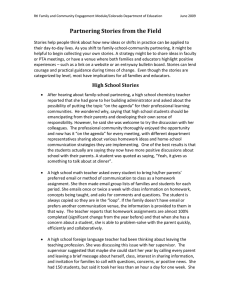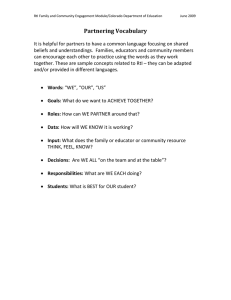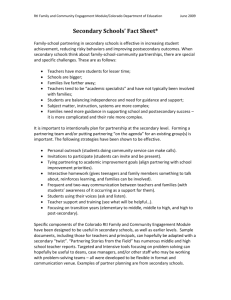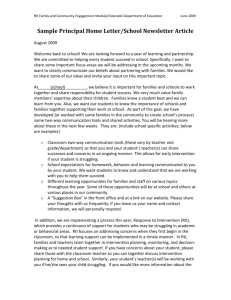Document 15590400
advertisement
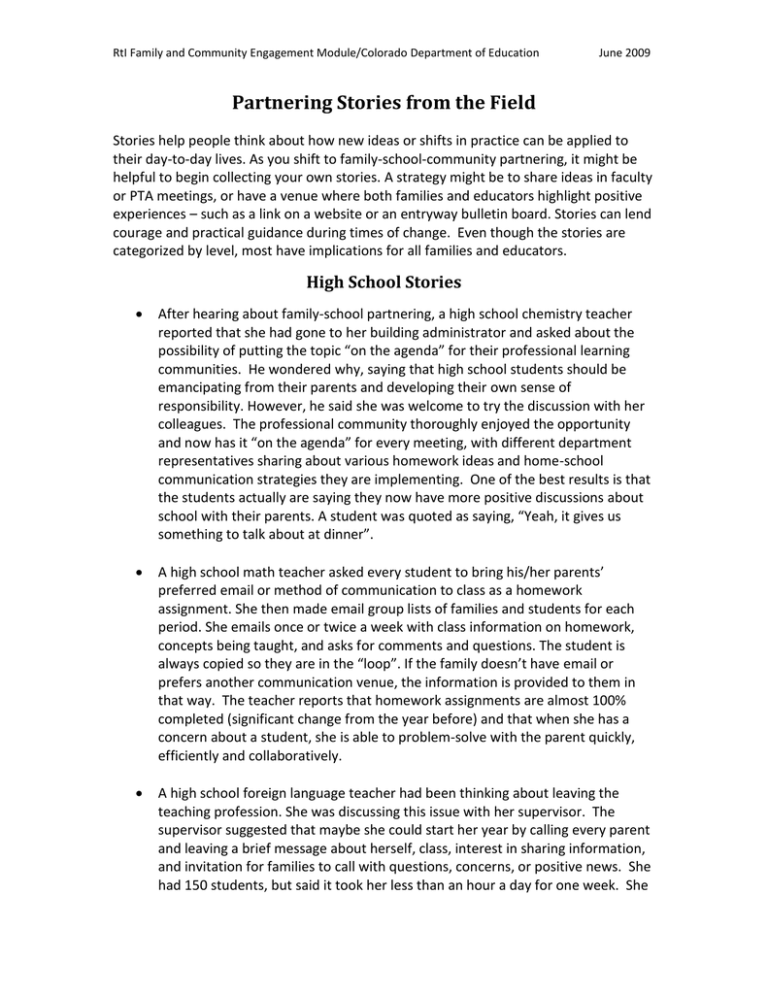
RtI Family and Community Engagement Module/Colorado Department of Education June 2009 Partnering Stories from the Field Stories help people think about how new ideas or shifts in practice can be applied to their day-to-day lives. As you shift to family-school-community partnering, it might be helpful to begin collecting your own stories. A strategy might be to share ideas in faculty or PTA meetings, or have a venue where both families and educators highlight positive experiences – such as a link on a website or an entryway bulletin board. Stories can lend courage and practical guidance during times of change. Even though the stories are categorized by level, most have implications for all families and educators. High School Stories After hearing about family-school partnering, a high school chemistry teacher reported that she had gone to her building administrator and asked about the possibility of putting the topic “on the agenda” for their professional learning communities. He wondered why, saying that high school students should be emancipating from their parents and developing their own sense of responsibility. However, he said she was welcome to try the discussion with her colleagues. The professional community thoroughly enjoyed the opportunity and now has it “on the agenda” for every meeting, with different department representatives sharing about various homework ideas and home-school communication strategies they are implementing. One of the best results is that the students actually are saying they now have more positive discussions about school with their parents. A student was quoted as saying, “Yeah, it gives us something to talk about at dinner”. A high school math teacher asked every student to bring his/her parents’ preferred email or method of communication to class as a homework assignment. She then made email group lists of families and students for each period. She emails once or twice a week with class information on homework, concepts being taught, and asks for comments and questions. The student is always copied so they are in the “loop”. If the family doesn’t have email or prefers another communication venue, the information is provided to them in that way. The teacher reports that homework assignments are almost 100% completed (significant change from the year before) and that when she has a concern about a student, she is able to problem-solve with the parent quickly, efficiently and collaboratively. A high school foreign language teacher had been thinking about leaving the teaching profession. She was discussing this issue with her supervisor. The supervisor suggested that maybe she could start her year by calling every parent and leaving a brief message about herself, class, interest in sharing information, and invitation for families to call with questions, concerns, or positive news. She had 150 students, but said it took her less than an hour a day for one week. She RtI Family and Community Engagement Module/Colorado Department of Education June 2009 reported having had many of the families saying thank you, responding with input, and that the students were surprised, but seem pleased “in their teenage ‘not admitting it’ way”. She says this has become her best year yet and she will stay in teaching. She will continue this practice every year. A high school teacher shares that, “I firmly believe that types of relationships and encounters that are in firm place between teachers and parents can have a profound effect on student learning and growth…. one of the reasons is that when students know that parents and teachers are working together, the students know they have support. They may not freely admit it, but this means a lot to high school students…I find joy in discussing my students with their parents and developing ways to improve their education…teacher education programs and school administration need to prepare teachers for positive parent Interactions and stress why they are so important.” (adapted from Mbadu, 2008) The same high school English teacher relates the following ideas about the importance of communicating with families. “A new student transferred into our school. He had a reputation for being tough, bad, and defiant. As time went on, I began to wonder what all the fuss was about. When the mother came into parent-teacher conferences, I shared that I enjoyed her son very much and he was earning a B in the class. She began to cry and told me that a teacher had never said anything nice about her son.” (adapted from Mbadu, 2008) A high school English teacher reported that the only training – in college, graduate school, or on the job - he had experienced in working with parents was “How to Survive Parent Conferences”. This had been a four-hour seminar in his teacher education program. He wanted to have professional development in working with families, as he found it so important in his everyday practice. He worked to find a class, didn’t find one, and so decided to work with his district to develop some in-service opportunities for other teachers. Middle School Stories An active advocate for family partnering, a seventh-grade teacher, was asked to describe her approach to communicating with families. Specifically, she was asked why she contacts parents, for what reasons, when, and how. The comments provided by this teacher represent several principles of effective communication and partnership skills, including the following: The student and his or her learning are at the center of all communications. Communication remains at the level of the issue and does not become personal. Concerns, not problems, are described. Parents are expert and critical to the success of the school’s efforts. RtI Family and Community Engagement Module/Colorado Department of Education June 2009 Contact is made early, before the concerns emerge or escalate. Positive messages are conveyed at the beginning of and throughout the contact. The communication is constructive and not punitive for the child. Perspective taking is encouraged. Good listening skills are important. Follow-up contacts are made. “Before I begin, there is one assumption that drives all of my dealings with parents. I believe that parents are my most important assets as a teacher. In addition, there are two things that I always think about when contacting a parent. First, I believe that all parents do what they believe is the best for their child . . . We may not agree with their opinion or action, but they do their best. Second, and perhaps most importantly, I try to think about how I would want a teacher or adult to handle the situation if this were my child (how would I want to be treated, and how would I want my child to be treated?).” (adapted from Christenson & Sheridan, 2001) A middle school RtI problem-solving team, including a student and her singleparent father, was meeting to brainstorm ideas about supporting positive behavior and homework completion. The family was from Russia and had been in the United States for two years – both father and daughter spoke English. The father shared that the daughter was a concert-level violinist and practiced with a teacher approximately three hours a day. No one at the school knew about this. The father then shared that the student’s mother had been killed while holding her daughter’s hand during a Russian political uprising about four years earlier. No one at the school knew about this either. The school had been considering a special education referral, but with the new information decided to partner with the family around a specific home-school-home support plan. The father began to cry and thanked the school staff for “caring so much about my daughter and me - no one had ever done that before”. The student cried and said it was so important that “my father came to school and could understand what it was like for me here.” A middle school student with a specific learning disability had not made any progress in math from one year to the next. He was two years below grade level. His family was very anxious and asked the school to change the student’s service delivery model from paraprofessional support in a general education classroom/grade level curriculum to a more intensive individual or small group focus on specific skills he needed. The school was not amenable to this request, saying that this was the special education math model at the school. The family strongly considered filing for due process, but instead opted to try and partner with the school staff in looking at data, exploring all available options, and trying RtI Family and Community Engagement Module/Colorado Department of Education June 2009 agreed-upon interventions. They requested a “problem-solving” meeting. The school agreed and upon examining all existing data with the family, decided to shift some resources and use homeroom time to support some specific small group remedial efforts for the student, in addition to the general education classroom. A basic skills curriculum was chosen. The family offered to provide some home tutoring. The team decided to review weekly skill tests and meet again in two months. The student began to show progress and demonstrated significant positive change on the state assessment, moving from unsatisfactory to partially proficient. Both school and family worked together to focus on student outcomes. Each party had to shift somewhat, but found common ground based on student data - an effective partnering strategy. Elementary Stories An elementary teacher has “learning open houses” once a month when families can come and share in a learning experience with their students. The topics and time vary, sometimes beginning at 7:00 in the morning or over the lunch hour or after dinner. The students are very successful at “helping their families to attend and participate”. The family members take away tools to support learning at home and report liking the “small” feel of the event. An elementary principal encourages teachers to have a “come early” or “stay late” day once a week so that they can connect with parents who are bringing or picking up their children at the school day care. The teachers then can take “flex time” on another day. The school has many working families. This has become a well-publicized and highly utilized communication venue for families and teachers. The strategy provides teachers more flexibility and the families feel that the school truly wants their partnership. References Christenson, S. L. & Sheridan, S. M. (2001). Schools and families: Creating essential connections for learning. New York, NY: Guilford Press. Mbadu, M. The power of parent-teacher relations. (2008, March 26). Retrieved March 6, 2009, from http://www.teachermagazine.org/tm/section/firstperson/2008/03/26/mbadu_first_ web.h19.html
